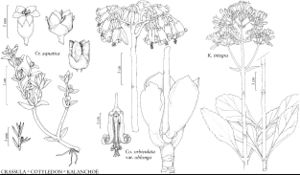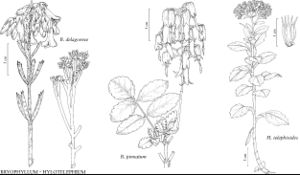Crassulaceae
Annual, biennial, or perennial herbs or shrubs [rarely scandent], succulent. Stems mostly alike and all potentially flowering, (flowering stems annual, axillary, overtopping primary stem). Leaves usually persistent, sometimes deciduous or caducous, cauline or sometimes in dense basal rosettes, alternate, opposite, or whorled, simple (pinnate in Bryophyllum), (heteromorphic in Dudleya, Echeveria, Graptopetalum); stipules absent; petiole usually absent; blade margins usually entire, sometimes toothed or lobed. Inflorescences terminal or axillary, spikes, thyrses, or mostly cymes, branches commonly cincinni (scorpioid cymes) and at first commonly coiled, or rarely flowers solitary. Flowers bisexual (sometimes unisexual in Rhodiola), radially symmetric (except sometimes calyx); perianth and androecium hypogynous or weakly perigynous; hypanthium present; sepals (3–)4–5(–12)[–30+], distinct or connate basally (or into tube); petals (3–)4–5(–12)[–30+], distinct or connate basally or sometimes into tube, margins entire (fimbrillate in Jovibarba, crenate in Phedimus); nectaries as scales at base of carpels; stamens as many as sepals or 2 times as many and in 2 series, antipetalous if in 1 series, free or adnate to corolla base (or tube); anthers dehiscent longitudinally and laterally; pistils (3–)4–5(–12)[–30+] [rarely fewer than sepals], mostly distinct or nearly so, (3–)4–5(–12)[–30+]-carpellate; ovary superior or semi-inferior, 1-locular; placentation submarginal; ovules anatropous, bitegmic, crassinucellate or tenuinucellate; styles (3–)4–5(–12)[–30+], terminal, distinct; stigmas (3–)4–5(–12)[–30], terminal, capitate. Fruits usually whorls of follicles, each dehiscent along adaxial suture, rarely whorls of flimsy 1-seeded utricles (Sedella) or capsules of basally connate pistils (Diamorpha, Jovibarba). Seeds 1–20+ per carpel, brownish, fusiform or ellipsoid; embryo straight; endosperm oily, scant.
Distribution
Nearly worldwide, mostly north-temperate regions and southern Africa.
Discussion
Genera ca. 35, species ca. 1400 (18 genera, 109 species in the flora).
Phylogenetic analyses (M. W. Chase et al. 1993; D. R. Morgan and D. E. Soltis 1993; D. E. Soltis and P. S. Soltis 1997; D. E. Soltis et al. 1997; M. E. Mort et al. 2001) confirm that Crassulaceae are monophyletic and place them in a Saxifragales clade. They are close to Saxifragaceae but differ in their predominantly succulent habit, their numerically regular flowers with the same number of sepals, petals, and pistils and as many or twice as many stamens, their separate nectaries, one at the base of each pistil, their mostly separate pistils, and their seeds with little or no endosperm. The only genus of questionable position has been Penthorum Linnaeus, sometimes placed here but clearly discordant. On the basis of embryology, J. Mauritzon (1933) found it closer to Saxifragaceae. From the anatomy, M. L. Haskins and W. J. Hayden (1987) thought it distinct from both and probably best kept as a separate family, Penthoraceae, as here. Podostemaceae also are thought related to Crassulaceae, although these submerged aquatics are so different and distinct that there are no intermediates.
In this family, as J. D. Hooker (1865) remarked, genera are poorly defined, and there has been much disagreement about them. Recent and continuing chemical and chloroplast-DNA studies by H. ’t Hart and associates (e.g., H. ’t Hart 1995) are shedding light on relationships and will continue to influence delimitation of genera, although thus far they are based on far too few American plants. U. Knapp’s (1994) seed studies also are helpful.
A. Berger’s (1930) division of the family into six subfamilies has been useful but is now seen as largely artificial. With new information, H. ’t Hart (1995) proposed a better system, with two subfamilies: the Crassuloideae as before, but the rest in the Sedoideae, with two tribes and one of these with two subtribes. Also, U. Knapp (1994) found the Crassuloideae unique in the jigsaw-puzzle testa of their seeds. ’t Hart found the very large, long-recognized genus Sedum to be paraphyletic but, in a compromise to avoid nomenclatural chaos, he kept Sedum mostly intact while still recognizing as genera several of the smaller, more distinct, related groups that seemed monophyletic, such as Phedimus in this treatment. There is still disagreement about which to recognize.
In a long and continuing series of cytological studies, C. H. Uhl (e.g., 1963) has dealt with most genera of Crassulaceae; particularly the American ones. Through many hundreds of crosses, he has directly or indirectly interconnected more than 200 species of Echeveria and relatives, to identify one of the largest comparia yet known, and has studied meiosis in hundreds of these hybrids. From the extent of chromosome pairing in diploid hybrids, he has learned much about the degree of relationship of the parents, sometimes assigned here to different genera. He has argued that, in contrast to most known polyploids of other families, natural polyploids of Mexican Crassulaceae generally are autoploid.
Many New World plants, as in present-day Dudleya, Echeveria, and Graptopetalum, were first named in Cotyledon, and are now recognized as being native only in the Old World, in Africa and Arabia.
Many herbarium specimens of Crassulaceae represent the plants poorly and lack the supplementary notes and photos or sketches that would make them most useful. Because succulent plants often die and dry very slowly in the plant press and so often grow out of shape or grow moldy, it is best to kill the tissues first so that they give up their moisture quickly. A good way, when possible, is to freeze the specimen solid, then, after thawing, to puncture the larger parts and milk the juice from them. Then it is best to change the papers or felts in the press several times in short order, to get rid of most moisture quickly and so avoid mold, then to arrange the specimen carefully in a natural position before final drying.
Selected References
Lower Taxa
Illustrations
Key
| 1 | Leaves connate basally, opposite, margins with glands (hydathodes) in submarginal rows; stamens as many as sepals; aquatic or terrestrial annuals or perennials; flowers 3-4(-5)- merous. | Crassula |
| 1 | Leaves not connate basally, sometimes subclasping, opposite, whorled, or alternate, margins without submarginal glands (sometimes glandular in Phedimus); stamens as many or 2 times as many as sepals (rarely absent); terrestrial annual, biennial, or perennial herbs, sometimes shrubs; flowers (3-)4-16-merous | > 2 |
| 2 | Petals connate into tube; leaves opposite or whorled | > 3 |
| 2 | Petals distinct or connate basally (if to middle then leaves rosulate); leaves opposite, whorled, or alternate | > 5 |
| 3 | Flowers 5-merous; calyx and corolla circumscissile at base in fruit; leaves sessile, margins entire; shrubs; California. | Cotyledon |
| 3 | Flowers 4-merous; calyx and corolla not circumscissile in fruit; leaves sessile or petiolate, margins entire or crenate to dentate or 1-2 times imparipinnate; herbs; Florida, Texas | > 4 |
| 4 | Flowers erect; sepals connate basally, not inflated; styles 2+ times shorter than ovaries; leaves simple; plants not viviparous; Florida. | Kalanchoe |
| 4 | Flowers pendulous; sepals connate basally or into tube, often inflated (unique to Bryophyllum); styles 2-4 times longer than ovaries; leaves simple or 1-2 times imparipinnate; plants viviparous with plantlets on leaf margins and inflorescences; Florida, Texas. | Bryophyllum |
| 5 | Perennial herbs; leaves cauline, not forming rosettes, dying back in winter to rootstock or tuberous base; leaf blades laminar, margins entire or dentate, serrate, or crenate | > 6 |
| 5 | Perennial, biennial, or annual herbs, sometimes shrubs; leaves clustered in persistent rosettes or not, sometimes with scattered, smaller, cauline leaves; leaf blades laminar to subterete, terete, subglobose, or planoconvex, margins entire or rarely ciliate (crenate in Phedimus) | > 7 |
| 6 | Ovary base attenuate, sometimes sharply narrowed; flowers 5-merous, bisexual; flowering stems from underground tuberous base, not from axils of scales; leaf blades 2-11 cm. | Hylotelephium |
| 6 | Ovary base straight; flowers 4-6-merous, bisexual or unisexual; flowering stems from axils of brown scale-leaves on stout rootstock partly above ground; leaf blades 1-5.5 cm. | Rhodiola |
| 7 | Flowers 6-16-merous; leaves in dense rosettes; petal margins ciliate or glabrous, fimbrillate or entire, (petals pink to purple, green, greenish white to greenish yellow or yellow, bright yellow, to cream, not cross-banded with red) | > 8 |
| 7 | Flowers (3-)4-5(-8)-merous; leaves in rosettes and/or cauline, scattered; petal margins glabrous, entire (if flowers 5-8-merous, then petals cross-banded with red; see. 17 Graptopetalum) | > 10 |
| 8 | Shrubs; leaves forming rosettes at ends of branches; California. | Aeonium |
| 8 | Perennial herbs; leaves forming basal rosettes; ne North America, Utah, Virginia, Wisconsin | > 9 |
| 9 | Flowers 8-16-merous; petals spreading, margins entire. | Sempervivum |
| 9 | Flowers 6(-7)-merous; petals erect, margins fimbrillate (unique in Jovibarba). | Jovibarba |
| 10 | Floral stems axillary (only annual, axillary stems flowering); leaves of floral stem scattered, smaller than rosulate leaves on perennial stem; petals connate basally | > 11 |
| 10 | Floral stems terminal or axillary (all stems potentially flowering); leaves of floral stem ± alike or gradually smaller distally; petals distinct or nearly so | > 13 |
| 11 | Petals connate basally, spreading or slightly reflexed from middle, red- banded in distal 1/2; flowers 5-8-merous, fetid. | Graptopetalum |
| 11 | Petals connate basally or to middle, erect, forming tube, or spreading from middle, not red-banded; flowers 5-merous, not fetid, mostly odorless | > 12 |
| 12 | Sepals all alike in size, erect; petals erect or spreading from middle; corollas forming cylindric tube or somewhat pentagonal; sw North America. | Dudleya |
| 12 | Sepals unalike in size, ascending; petals erect; corollas pentagonal-pyramidal; Texas | Echeveria |
| 13 | Inflorescences spikes or racemes or narrow thyrses; Texas | > 14 |
| 13 | Inflorescences cymes, sometimes compound; widespread | > 15 |
| 14 | Leaves opposite (at least proximal ones), blade elliptic or ovate-lanceolate to oblanceolate, planoconvex; petals distinct. | Lenophyllum |
| 14 | Leaves alternate, blade linear, subterete; petals connate basally. | Villadia |
| 15 | Fruits capsules, dehiscent by valves, or utricles; plants annual; California or se United States. | > 16 |
| 15 | Fruits follicles; plants annual, biennial, or perennial; widespread. | > 17 |
| 16 | Flowers 5-merous, subsessile; fruits utricles; stamens as many or 2 times as many as sepals; California. | Sedella |
| 16 | Flowers 4-merous, pedicellate; fruits cruciate capsules, dehiscent by abaxial valves; stamens 2 times as many as sepals; se United States. | Diamorpha |
| 17 | Leaf blades terete or subterete, margins entire. | Sedum |
| 17 | Leaf blades laminar, margins crenate. | Phedimus |


